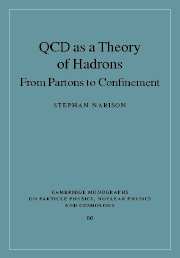Book contents
- Frontmatter
- Contents
- About Stephan Narison
- Outline of the book
- Preface
- Acknowledgements
- Part I General introduction
- Part II QCD gauge theory
- Part III MS-bar scheme for QCD and QED
- Part IV Deep inelastic scatterings at hadron colliders
- Part V Hard processes in e+e– collisions
- Part VI Summary of QCD tests and αs measurements
- Part VII Power corrections in QCD
- Part VIII QCD two-point functions
- Part IX QCD non-perturbative methods
- Part X QCD spectral sum rules
- Part XI Appendices
- Bibliography
- Index
Part VI - Summary of QCD tests and αs measurements
- Frontmatter
- Contents
- About Stephan Narison
- Outline of the book
- Preface
- Acknowledgements
- Part I General introduction
- Part II QCD gauge theory
- Part III MS-bar scheme for QCD and QED
- Part IV Deep inelastic scatterings at hadron colliders
- Part V Hard processes in e+e– collisions
- Part VI Summary of QCD tests and αs measurements
- Part VII Power corrections in QCD
- Part VIII QCD two-point functions
- Part IX QCD non-perturbative methods
- Part X QCD spectral sum rules
- Part XI Appendices
- Bibliography
- Index
Summary
The different observables
We have discussed in the previous two parts of this book, deep inelastic scatterings in hadron colliders and different hard processes in e+e– annihilations. These hard processes have been used for testing the underlying ideas of perturbative QCD at short distances. Among others, one has studied and measured:
Scaling violations in different parton model sum rules.
Structure functions.
Spin content of the proton.
Fragmentation functions.
Spin of the photon.
One hadron inclusive production.
Jets.
Total inclusive e+e– cross-sections.
Hadronic τ and Z0 decays.
In all these hard processes, most of the perturbative QCD predictions based on the SU(3)c colour group and on asymptotic freedom properties have been confirmed by the data.
Different tests of QCD
The main outcomes of these analysis in the previous parts of the book are given in the following sections.
Deep inelastic scatterings
A measurement of the scaling violations to parton model predictions in deep inelastic processes using different moments of the structure functions as predicted by QCD. In the unpolarized case, one has used these processes to extract the value of the QCD running coupling. In the polarized case, one has been able to emphasize the important universal rôle of the QCD anomaly for explaining the relative suppression of the first moment of the structure function compared to the OZI prediction (so-called proton spin) and a proposal for testing its effect from the measurement of the photon spin in γ-γ scattering processes, and of some semi-inclusive processes.
[…]
- Type
- Chapter
- Information
- QCD as a Theory of HadronsFrom Partons to Confinement, pp. 275 - 282Publisher: Cambridge University PressPrint publication year: 2004



